

Caster flutter is defined as the movement of a swivel caster where the wheel continues rolling forward while the rig swivels side to side. It causes what appears to be a “fluttering” motion or what could be described as a shimmy or shaking movement (certainly not the dance…). This movement results in excessive vibration, increased wheel/caster wear, and decreased towing and tracking ability.
Once you evaluate your application for those potential causes, then you can take proper action to remedy the situation.
In industrial applications, caster flutter results when a swivel caster reaches some sort of resonance frequency. This frequency of vibrations is higher with less mass, shorter swivel leads, and higher traveling speeds.
Of all the factors that can cause caster flutter in industrial casters, these three are the most common:
Moving at High Speeds – At high speeds, a caster will flutter once it hits a certain velocity and is excited at its natural frequency. In most applications involving industrial casters and wheels, the wheel is not balanced and lends itself to fluttering.
There are steps you can take to minimize the occurrence of caster flutter. From increasing swivel lead and wheel composition to moving at slower speeds, these options are the best ways to control the situation.
By increasing swivel lead you reduce the forces that push the caster sideways. It also increases the caster’s natural resonance frequency. This helps keep the caster from fluttering at low speeds.
Incorporating a precision bearing swivel section is another way to minimize caster flutter. A swivel section manufactured to tighter tolerances allows for less play in the swivel section, which increases the resonance frequency. Also switching to a swivel section that has more “drag” (i.e. harder to rotate) will also decrease the chances of flutter. Sometimes swivel restrictors/dampeners are used to create this friction. The downside is it makes the cart or trailer harder to move manually.
Just as increasing swivel lead increases the natural frequency of the caster, changing the mass of the wheel will change the resonance frequency. You can either make the wheel lighter or heavier depending on the application.
Increasing the friction between the wheel and the ground will also help to reduce flutter. For example, using a softer wheel with a larger contact patch will provide more friction. This dampens the oscillation and reduces the chance of building resonance.
Reducing Velocity– The faster the caster is moving, the higher the chance for flutter. At low speeds, 2 or 3 MPH, a swivel caster may behave quite well. However, at 8-10 MPH, that same caster may flutter uncontrollably. If higher speeds are required, then try to change the other factors listed above.
I hope this helps you understand more about what caster flutter is and what variables you can examine to try and reduce the effect.